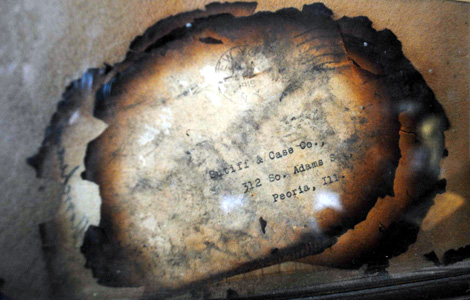Hazardous Mail
A simple scrap of paper reminds us of a time when delivering letters cross-country was risky business
Back in the 1990s, I spied a piece of burned paper in a dusty Illinois junk shop. For 20 bucks, I purchased a singed envelope that had been placed in a mailbox in 1919, postmarked in New York, and sent by airmail to Sutiff & Case Co., in Peoria. The letter was never delivered. Also inside the cheap wooden frame — with a broken string attached, indicating that it once hung on a wall — was an apologetic letter dated May 28, 1919, from W.B Carlile, the Chicago postmaster:
The enclosed piece of mail matter was damaged in the aero-plane accident at Cleveland, Ohio, May 25th.
The incident is very much regretted.
When those papers were first displayed, American airmail service was little more than a year old — the U.S. Army had begun flying regularly scheduled flights on May 15, 1918, with deliveries between Washington, Philadelphia, and New York. In August, the Army turned the operation over to the Postal Service. The accompanying newspaper clipping described the crash of Frank McCusker, who was flying the newly inaugurated New York-to-Cleveland route, and was the second Postal Service air pilot to perish when his de Havilland DH-4 caught fire after taking off from Cleveland. The doomed and parachute-less pilot jumped to his death.
Those seminal years were extremely dangerous for airmail pilots — flying surplus aircraft, with little more than a sight of a river or road for navigation. Some were veterans of the Great War; others were barely out of flight school. Between 1919 and 1926, 35 pilots died hauling Christmas missives, overdue bills, and humdrum human communication now delivered with a mouse click.
Indeed, by 1975, the term “air mail” would be dropped from Postal Service lexicon; today nearly every letter travels most of its journey as unremarkable baggage beneath the feet of thousands of bored flyers dozing toward their hurried connection in Atlanta or Dallas. And yet, it’s hard to look at that charred letter and not think of the bravery of Frank McCusker as he climbed into an open cockpit 94 years ago, daring the clouds that lay ahead.
/https://tf-cmsv2-smithsonianmag-media.s3.amazonaws.com/accounts/headshot/Sotham_photo.jpg)

/https://tf-cmsv2-smithsonianmag-media.s3.amazonaws.com/accounts/headshot/Sotham_photo.jpg)